Just to explain, the blog ‘Looking forward and catching up with ‘Medieval Animals” from early July (number 5) is currently completely ‘gone’ until I recover the Word file on which it was based from Diane, which means the next blog that I can reinstate, albeit not exactly as it was in the second week in July, is the sixth ‘lost’ blog.
Before I come to the main section of the blog this week on Michael Wood’s brilliant Becket Lecture on Theodore of Tarsus and Hadrian, ‘A Man of African Race’, I thought I would flag up a couple of forthcoming events in Canterbury and Rochester. Additionally, the first of the three ‘Working with Wills’ workshops took place at Dover last Saturday and the temporary exhibition in St Mary’s church on ‘Medieval Dover – Maritime Community’ will be there until next week, and to note as well that Tracey Dessoy gave a presentation to the Kent History Postgraduates this week.
I’ll start with Canterbury. If you would like to learn more about pilgrimage and St Thomas’ hospital’s role in this vital and fascinating aspect of life in the late medieval city, as well as the hospital’s other charitable activities, please do consider coming to my talk at Eastbridge on Thursday 27th July 2023 at 3pm, followed by refreshments. To book, please contact Julia on jbrown@eastbridgehospital.org.uk or call 01227 471688, or purchase a ticket by calling into Eastbridge or the Franciscan Gardens. This is part of the CKHH’s efforts to support the wonderful historic institutions within the city.
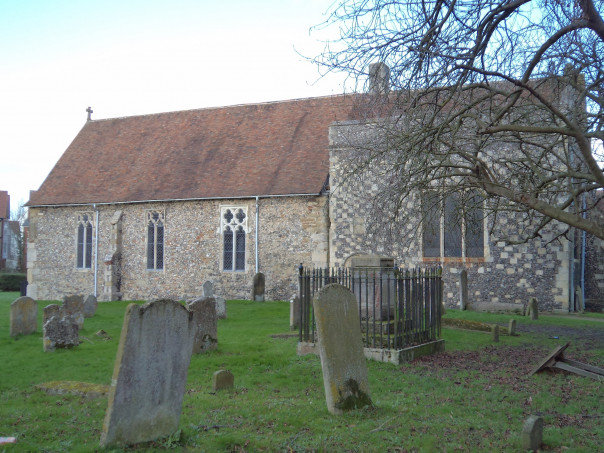
We are also delighted to support St Mildred’s church and, as reported last week, the church will be holding a series of events on Saturday 15 July starting at 11am with the Ukrainian Choir, an organ recital by Professor Stephen Banfield at noon, to be followed by Professor Paul Bennett’s tour and talk on the architectural development of the church at 1pm with the final presentation at 2.15pm being given by the Revd Dr Lesley Hardy on St Mildred. To be followed by a cream tea, donations sought because, as reported several weeks ago, the church has a squirrel problem.
So to Rochester and last week the cathedral launched its new exhibition in the crypt (throughout July and August) entitled ‘Gargoyles, Grotesques and Medieval Beasts’ which features works by the Kent Association of Blind Art Groups, Peer Arts and Deaf Peer Arts, local primary schoolchildren engaged in workshops run by MESS ROOM CIC and with input from Dr Diane Heath’s ‘Medieval Animals Heritage’ project. In addition, Rochester Cathedral is delighted to feature the Rochester Bestiary on loan from the British Library which is another attraction for those visiting this great exhibition.
Next, Tracey provided members of the Kent History Postgraduates (in person and online) with a fascinating case study on an aristocratic lady Agnes de Condet, who had connections to Canterbury and east Kent. Agnes’ case is extremely interesting because she made her will during her husband’s lifetime, having received his permission. Tracey has been studying this will for what it tells us about Agnes’ pious and charitable works, but this time her focus was on this noble woman’s landed interests in Kent and what her bequests can suggest about her household and her estates. For not only did the manor of Wickham include farmland, but also a good-sized deer park, and among the servants listed in Agnes’s will was Adam the park keeper. Tracey also explored the symbolic value contemporaries would have placed on Agnes’ bequest and this sparked a discussion afterwards on how wills can be good indicators on such matters, albeit such documents are far more plentiful from the later medieval period. Thanks, Tracey, for these insights into your research and the group has one more catch-up meeting towards the end of July before breaking and returning to meet in September.
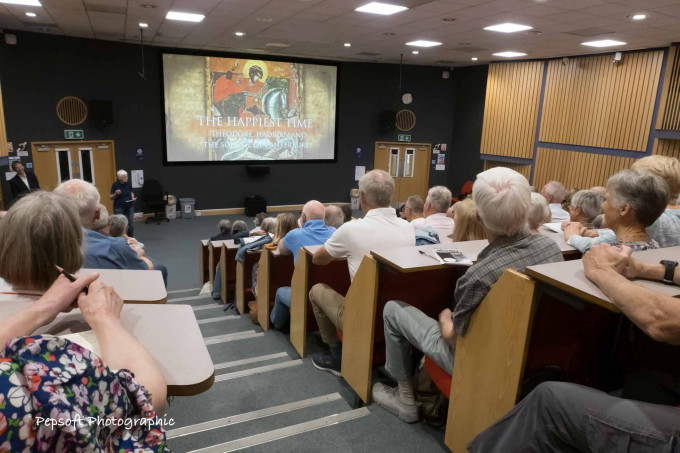
Now to Michael Wood’s Becket Lecture where the audience in the packed lecture theatre was treated to a tour de force on arguably two of the most influential men in the history of Christianity in the British Isles, as well as western Christendom more broadly. As Michael pointed out as he took us through their important roles in their respective homelands of the Middle East and north Africa, before their later travels to Sicily and Rome, these senior churchmen had been involved in education, diplomatic missions and some of the key theological debates in Christendom before the later split between the Eastern and Western Churches. Moreover, as he highlighted, both Theodore and Hadrian had had full careers even before they travelled together from Rome to Canterbury, yet each was to spend decades in England where they revitalised the Church and set it on its course for the next almost a thousand years and beyond because their influence did not end totally with the Reformation.
However, we are only now getting a fuller picture of just how important these churchmen and their school in Canterbury were for the development of the medieval Church as more manuscript discoveries are made in libraries and archives across Europe as we piece together the spread of texts and the knowledge within them. Thus, there is more to be discovered and while Michael has included a chapter on them in his newly revised and extended In Search of the Dark Ages, this might be said to be their preliminary story with more to come.
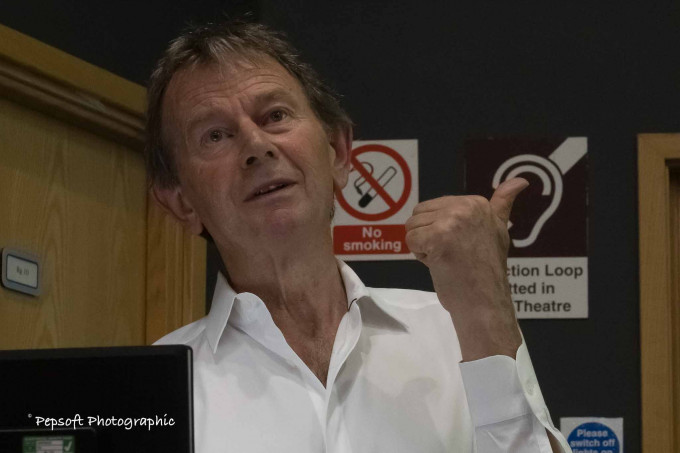
Returning to their important role as teachers, unlike Augustine, they were able to bring to England in 669 what would have been seen as an amazing array of texts by contemporaries, and thereafter more texts would pass back and forth as they revitalised learning, bring materials in Greek as well as Latin, and even in Syriac.
What is also interesting is the role of the vernacular in their teaching at their school at Canterbury, and Michael demonstrated what we know about their teaching methods and how, through the use of different languages, they sought to show their pupils the natural wonders of the world, as well as matters relating to theology. For they adopted a wide curriculum, seeking to impart knowledge concerning other areas as well such as history, medicine, philosophy and literature. Moreover, this powerhouse and flowering of scholarship was not confined to Canterbury, and they travelled extensively together in Britain. Their endeavours helped to bring into being the monastery at Wearmouth, founded by Benedict Biscop a Northumbrian nobleman, with a slightly later sister house nearby at Jarrow, all three men understanding the imperative to preserve, copy and disseminate classical works from the Mediterranean world before they were lost forever. Indeed, as those who visited the Anglo-Saxons exhibition in London a couple of years ago will remember, the Codex Amiatinus, the world’s earliest surviving Latin Bible, was produced at Wearmouth-Jarrow during this period.
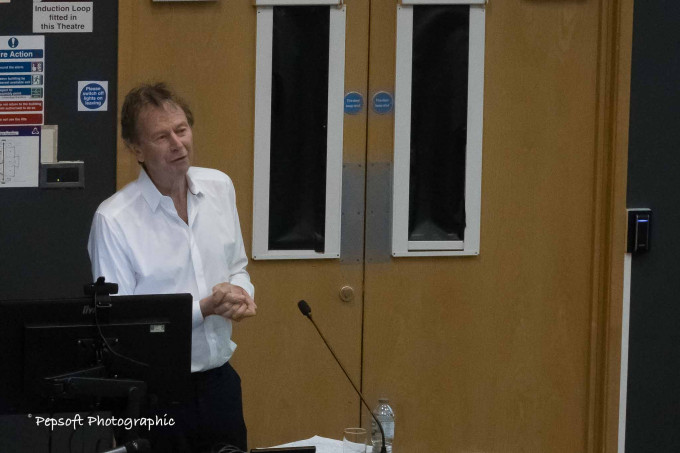
Michael finished his fascinating lecture by highlighting Theodore’s and Hadrian’s legacy in terms of their pupils and their pupils’ pupils. This genealogy of great scholars is amazing and as you might expect amongst these stars is Aldhelm, who was taught by them, and was “one of the most brilliant Latinists of the early medieval west” and then a century later we have another star in Alcuin of York, who considered what these two men had brought was “the wisdom of Greece, Roman Latin culture, the Hebrew biblical tradition, ‘and the light that came out of Africa’”.
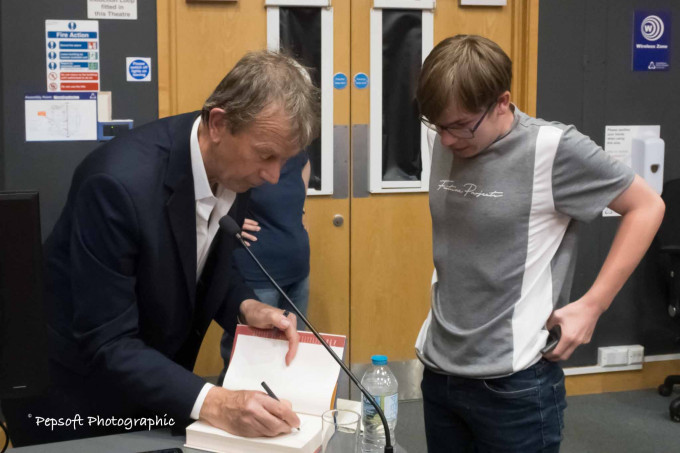
Such a great lecture provoked a number of questions and then Michael generously took time to chat to members of the audience and sign books purchased from the CCCU Bookshop. For Craig had kindly stayed open to facilitate this after the lecture, and it was clear from the excited buzz that the audience had had great time, an idea reiterated in emails from people that arrived the following day. So a highly successful Becket Lecture and many thanks to Michael for coming down to Canterbury.
 Centre for Kent History and Heritage
Centre for Kent History and Heritage Sheila Sweetinburgh
Sheila Sweetinburgh 1019
1019

